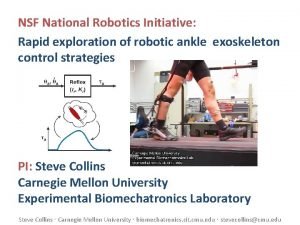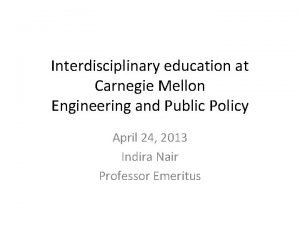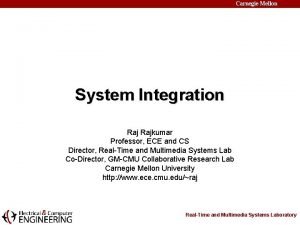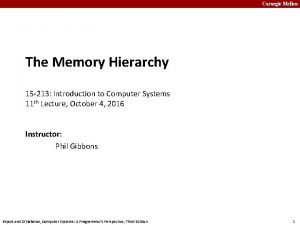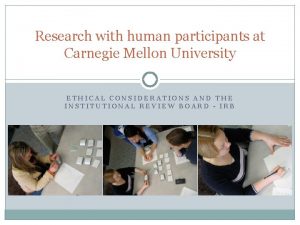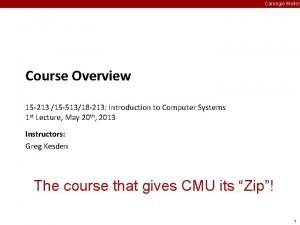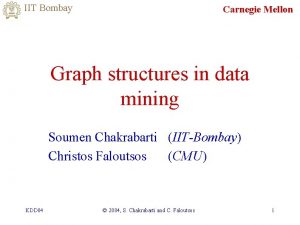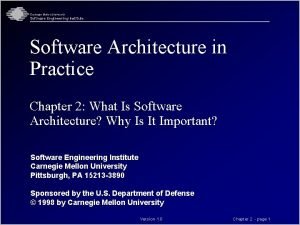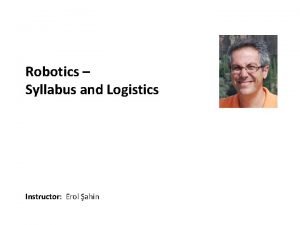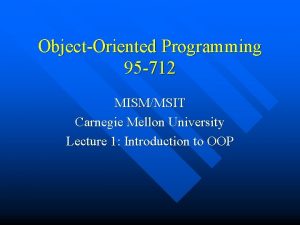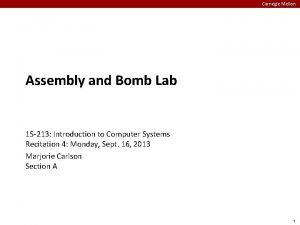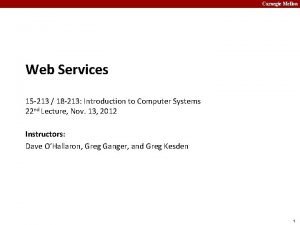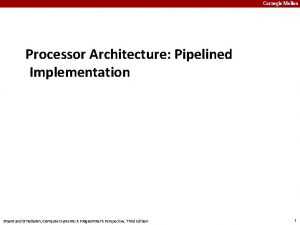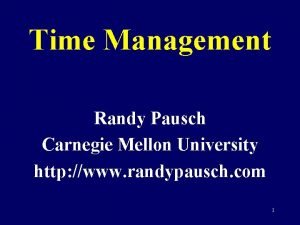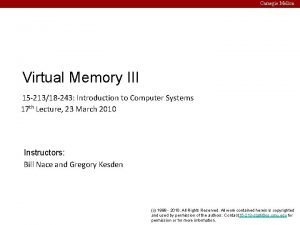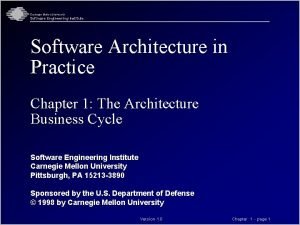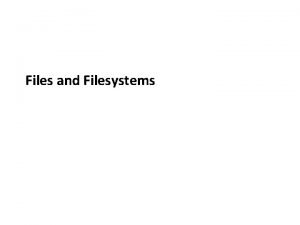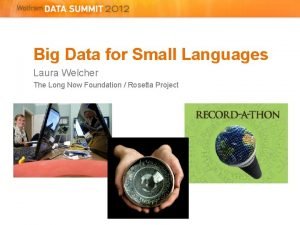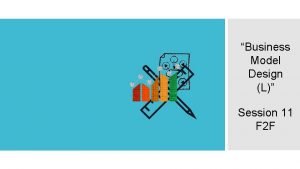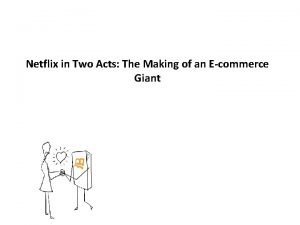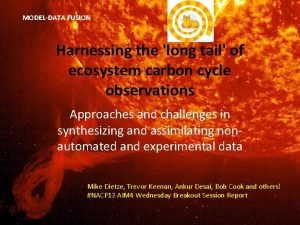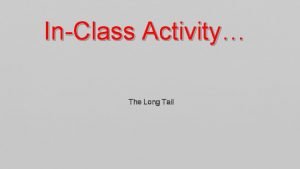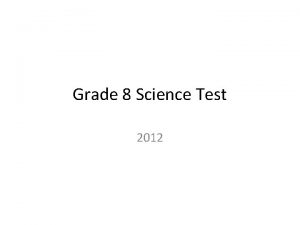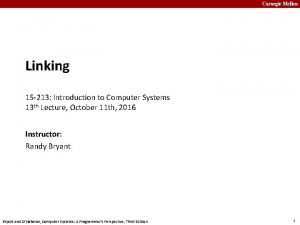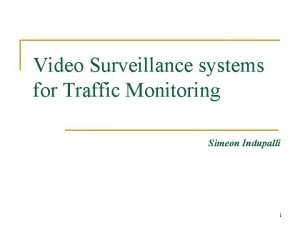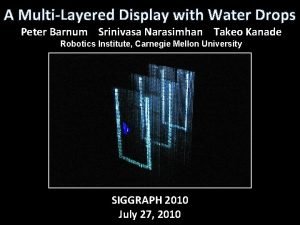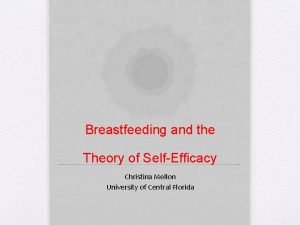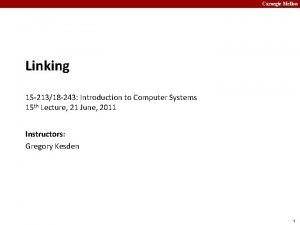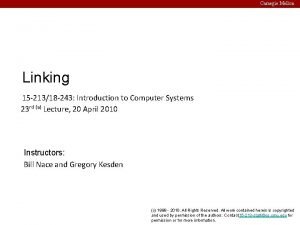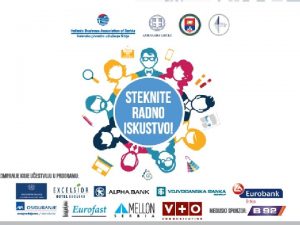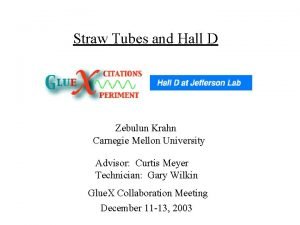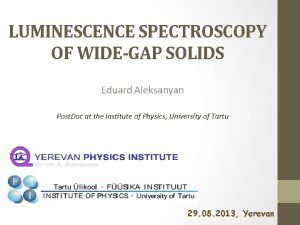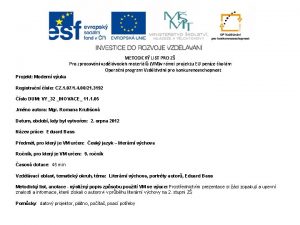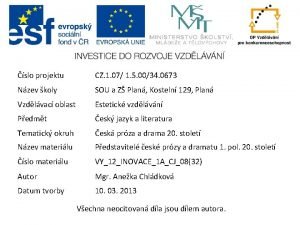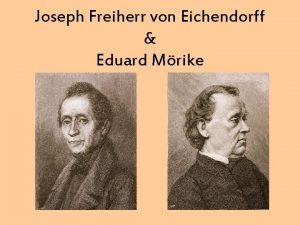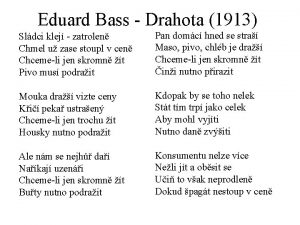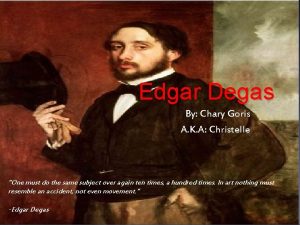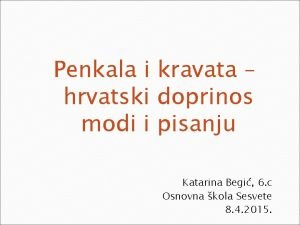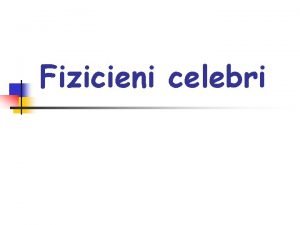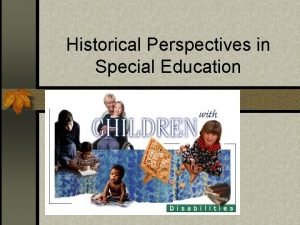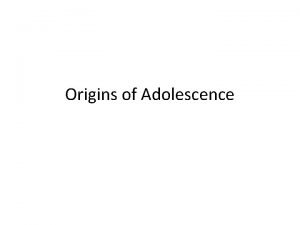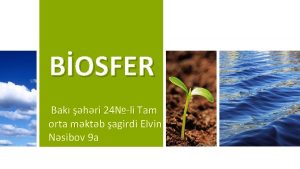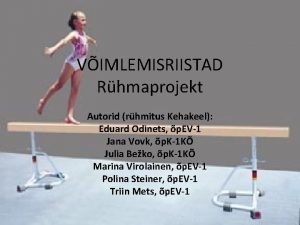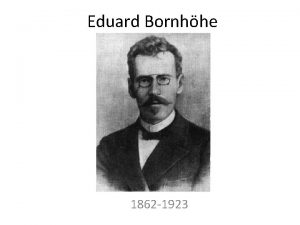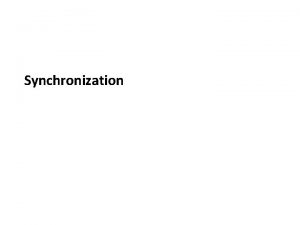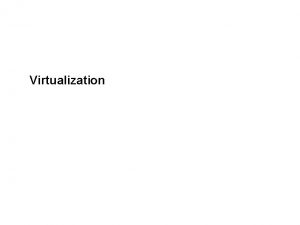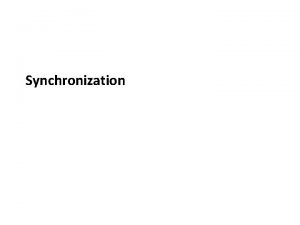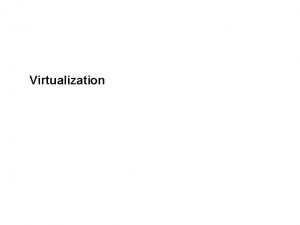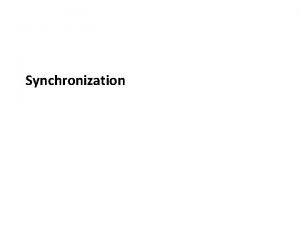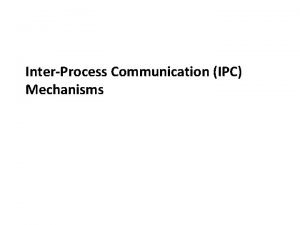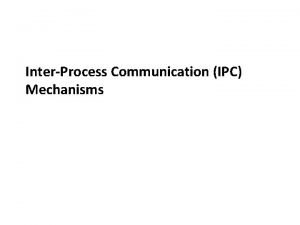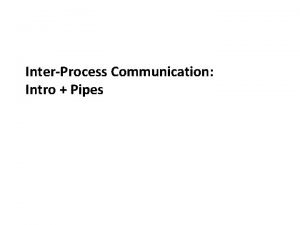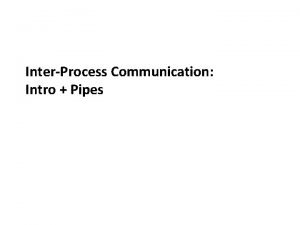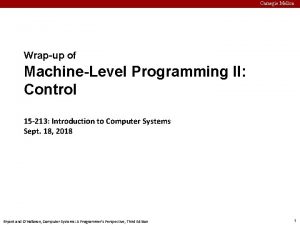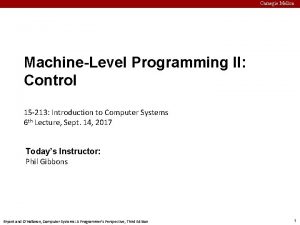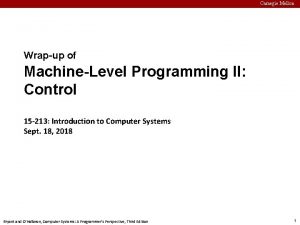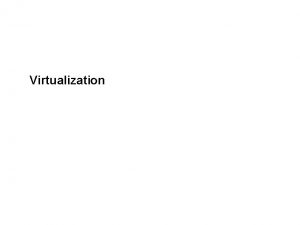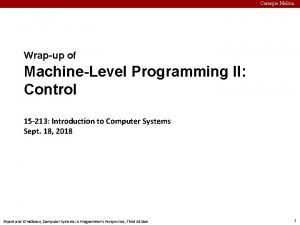Filling the Long Tail Eduard Hovy Carnegie Mellon
















![SAFT project: Hypothesis of our work When you read a [set of] text[s], you SAFT project: Hypothesis of our work When you read a [set of] text[s], you](https://slidetodoc.com/presentation_image_h/ab9467c7a537ab939b55321a3b0bb6ea/image-17.jpg)











































- Slides: 60

Filling the Long Tail Eduard Hovy Carnegie Mellon University www. cs. cmu. edu/~hovy


Webclopedia Example: Webclopedia QA • Where do lobsters like to live? — on the table • Where are zebras most likely found? — in the dictionary • How many people live in Chile? — nine • What is an invertebrate? — Dukakis (Hovy et al. 01)


Why? • Today: illusion that NLP systems ‘understand’ through – clever problem decomposition – use of resources like Word. Net, online dictionaries, Prop. Bank… • To do more than surface-level transformation, systems need to ‘understand’ • The Long Tail is full of phenomena required for understanding

What can NLP do well today? • Surface-level preprocessing (POS tagging, word segmentation, NE extraction, etc. ): 97%+ 00 s– • Shallow syntactic parsing: 94%+ for English 00 s– (Charniak, Collins, Lin) and deeper analysis (Smith) • IE: ~60% for well-behaved topics (MUC, ACE) 80 s– • Speech: ~80% large vocab; 40%+ open vocab, noisy input 80– 90 s • IR: 45%+ (TREC) 00 s– • MT: ~70% depending on what you measure 90– 00 s • Summarization: ? (~60% for extracts; TAC) • QA: ? (~60% for factoids; TREC) 00 s–

So if the answer is ‘semantics’, which aspects of semantics? How many aspects? How do we acquire the knowledge?

Semantics in IBM’s Watson QA system • ~2006: IBM tackled the problem of QA • In 55 real-time test games against former Jeopardy! champions, Watson won 71% • About 105 subdomain specialists

(Watson team online) Watson’s Lexical Answer Types • Found 2500 distinct explicit LATs in 20, 000 questions – Most frequent 200 explicit LATs cover less than 50% of the data • Using many independent answer-typed algorithms: – Most use own type system – “The best way to integrate preexisting components is not to force them into a single, common type system, but to have them map from the LAT to their own internal types” • Approximate distribution of the 50 most frequent Freebase relations in 20, 000 randomly selected Jeopardy! clues:

(Weston et al. 2015) Single-doc QA • Weston et al. (2015): Towards AI-complete Question Answering: A Set Of Prerequisite Toy Tasks • Classify understanding and reasoning tasks into skill sets:

Jerry Hobbs bought the green Toyota yesterday He and the seller were both happy (e 1 : type Action : act buy : agent (x 0 : type Person : name “Jerry Hobbs”) : patient (x 1 : type Car : make “Toyota” : color (x 2 : type Color : value green)) What is to ‘buy’? : price [$2000 – $25000] Who is Jerry Hobbs? Cause : time (x 3 : type Time : value yesterday)) What is ‘green’? (e 2 : type Happiness-state What price range? : experiencer {x 0, seller} Who’s this ‘seller’? : value high) Why is he happy? (x 4 : type Person (“seller”))

The general and the specific • Microtheories: General – – – – Location: point/region, spatial inclusion… Time: point/interval, typical event lengths… Coref: various types of partial identity Numerical info: typical value ranges Role fillers: semantics and metonymy Background knowledge: facts Background knowledge: concepts, inheritance, and concept facets • Micro-contexts: Specific Variations just of: Time/Loc/Depiction/ Role/Substep… Normal or anomalous events Multiple inheritance, Perspective – Composed structures: goals, plans, scripts… – Instantiated subsets (terms & microtheories) – Specific coref/concept facets: various types of partial identity – Change over time

Too many! So, focus on enabling techniques… • Discrete rep symbols —> Continuous tensors/embeddings • Latent relations • Special-purpose micro-‘theories’ for – – Numbers Locations, dates, times, etc. Social roles, etc. • Dynamic collections of background facts & concepts • Semantic compositionality (to smoothly integrate individual discrete representation fragments): – Role filler constraints / selectional preferences – Property-based compositionality – Anomaly detection Goyal et al. 2013 Srivastava 2014 Xue and Hovy 2016 Faruqui et al. 2015 Jauhar and Hovy 2015 Peñas and Hovy 2010 Kozareva et al. 2010 Goyal et al. 2013 Dasigi and Hovy 2014 Jauhar and Hovy

Talk overview • • • Introduction Factual knowledge (A-Box) Conceptual knowledge (T-Box) Higher-level concepts and abstractions Conclusion and thoughts from today’s talks

FACTUAL KNOWLEDGE TO SUPPORT INFERENCE

The DEFT program • DARPA program, in year 4 of 6: – Teams from all over the country – BBN assembles the software in its ADEPT system; downloadable – Follows prior Machine Reading Program (MRP) • Goals: Machine Reading for Knowledge Base Population (KBP) – Component technologies and evaluations: • Parsing, entity detection, entity linking, entity and event coref, event mention detection, event relation extraction, slot-filling, KBP from scratch (= “Cold Start”) – Languages: English, Chinese, Spanish – Training data from LDC; all kinds of useful stuff – Evaluations run by NIST: annual TAC conference 21
![SAFT project Hypothesis of our work When you read a set of texts you SAFT project: Hypothesis of our work When you read a [set of] text[s], you](https://slidetodoc.com/presentation_image_h/ab9467c7a537ab939b55321a3b0bb6ea/image-17.jpg)
SAFT project: Hypothesis of our work When you read a [set of] text[s], you don’t just do sentence-based frame-level analysis; you use various kinds of external knowledge that support one another in complex ways and apply various additional processes to produce a richly interconnected result, with predictions and explanations. 22

An example from MRP William Floyd rushed for three touchdowns and Steve Young scored two more, moving the San Francisco 49 ers one victory from the Super Bowl with a 44– 15 football rout of Chicago struck first, recovering a fumble to set up a 39 yard Kevin Butler field goal for a 3– 0 lead just 3: 58 into the game. But nothing went right for the Bears after that. The 49 ers moved ahead 7– 3 on Floyd’s two-yard touchdown run 11: 19 into the game. San Francisco’s Eric Davis intercepted a Steve Walsh pass on the next series to set up a seven-yard Young touchdown pass to Brent Jones.

Example knowledge gaps William Floyd rushed for three touchdowns and Steve Young scored two more, moving the San Francisco 49 ers one victory from the Super Bowl with a 44– 15 football rout of Chicago. But nothing went right for the Bears after that. The 49 ers moved ahead 7– 3 on Floyd's two-yard touchdown. San Francisco’s Eric Davis intercepted a Steve Walsh pass on the next series to set up a seven-yard Young touchdown pass to Brent Jones. • Two more what? • How do you ‘rush for a touchdown’? Is that the same as ‘make a touchdown? ’ Or as ‘drop a touchdown attempt’? • What is the connection between San Francisco and the 49 ers? And with Floyd? • How do you ‘move one victory’? How do you ‘move it from the Super Bowl’? • What is a ‘two-yard touchdown’? Is this how far you move? • What is a ‘Steve Walsh pass’? • What is a ‘Young touchdown pass to Brent Jones’?

Goyal et al. , ACL 2013 Background knowledge: The Prop. Store • Prop. Store: simple triple store • Can extract arbitrarily complex structures with counts • Build: Parse sentences, [do coref], extract head noun of each syntactic role, save triple (with pointers), at end group together by role • Contents: – – Words, lemmas, supertags, POS tags [words x syntactic relations] Current size (English): ~4 billion triples in 800 databases (~2 TB) Multiply indexed for rapid retrieval and vector/tensor assembly

Prop. Store statistics, 2016 • The Prop. Store: A triple store in 3 languages from Wikipedias: – Fast, well-implemented – English (wikipedia size = 9. 2 GB): • • dictionary 9. 736. 628 triples (approx. ) 191. 255. 059 triples occurrences (approx. ) 1. 825. 690. 862 Corresponding to: 4. 673. 942 documents, containing 87. 923. 068 sentences – Spanish (wikipedia size = 2. 3 GB): • • dictionary 3. 571. 805 triples (approx. ) 60. 414. 469 triples occurrences (approx. ) 444. 864. 366 Corresponding to: 1. 103. 688 documents, containing 18. 556. 523 sentences – Chinese (wikipedia size = 0. 6 GB): • • dictionary harder to quantify because of character-based writing triples (approx. ) 15 M triples occurrences (approx. ) 100 M Corresponding to: approx. 0. 3 M documents containing 4. 5 M sentences • Plan to use to augment entity and event information in reading 28

Using the knowledge service Example: San Francisco's Eric Davis intercepted a Steve Walsh pass on the next series to set up a seven-yard Young touchdown pass to Brent Jones. Implicit (More) explicit San Francisco’s Eric Davis plays for San Francisco Eric Davis intercepted pass — Steve Walsh pass Steve Walsh threw interception Young touchdown pass Young completed pass for touchdown pass to Brent Jones caught pass for touchdown These are inferences on the language side

Example: Queries to football Prop. Store ? > NPN 'pass': X: 'touchdown‘ NPN 712 'pass': 'for': 'touchdown' NPN 24 'pass': 'include': 'touchdown’ … ? > NVN 'quarterback': X: 'pass' NVN 98 'quarterback': 'throw': 'pass' NVN 27 'quarterback': 'complete': 'pass‘ … ? > NVNPN 'NNP': X: 'pass': Y: 'touchdown' ? > NVN 'end': X: 'pass‘ NVNPN 189 'NNP': 'catch': 'pass': 'for': 'touchdown' NVN 28 'end': 'catch': 'pass' NVNPN 26 'NNP': 'complete': 'pass': 'for': 'touchdown‘ NVN 6 'end': 'drop': 'pass‘ … … ? > NN NNP: ’pass’ ? >X: has-instance: ’Marino’ 20 'quarterback': has-instance: 'Marino' NN 24 'Marino’: 'pass‘ 6 'passer': has-instance: 'Marino' NN 17 'Kelly': 'pass' 4 'leader': has-instance: 'Marino' NN 15 'Elway’: 'pass’ 3 'veteran': has-instance: 'Marino' … 2 'player': has-instance: 'Marino' 32

Enrichment example: 1 …to set up a 7 -yard Young touchdown pass to Brent Jones Young touchdown nn nn Jones to pass Young pass ? > X: has-instance: Young X=quarterback ? > NVN: quarterback: X: pass X=throw X=complete Pass to Jones ? > X: has-instance: Jones X=end ? > NVN: end: X: pass X=catch X=drop

Enrichment 2 …to set up a 7 -yard Young touchdown pass to Brent Jones Young touchdown throw complete nn pass touchdown pass ? > NVN touchdown: X: pass False ? > NPN pass: X: touchdown X=for Jones catch drop

Enrichment 3 …to set up a 7 -yard Young touchdown pass to Brent Jones Young throw complete touchdown for pass ? > NVNPN NAME: X: pass: for: touchdown X=complete X=catch Jones catch drop

Enrichment 4 …to set up a 7 -yard Young touchdown pass to Brent Jones Young complete touchdown for Jones catch pass Young complete pass for touchdown Jones catch pass for touchdown

Example enrichment result San Francisco's Eric Davis intercepted a Steve Walsh pass on the next series to set up a seven-yard Young touchdown pass to Brent Jones. Before enrichment After enrichment 37

Factual knowledge • Our systems don’t remember what they read a minute ago! • Decomposing input into minimal units allows easy confidence scoring and inconsistency/novelty discovery • …this sets up the ‘knowledge frontier’ — the things about which the system should want to know more • This provides the reader with curiosity

OBTAINING AND ORGANIZING CONCEPTUAL KNOWLEDGE

A challenge: learning ontologies Given a domain, can we from the web learn its structure (metadata) and instances simultaneously? That is, can we learn… – instance/basic level terms? – non-instance terms and their organization? – …with no (or minimal) supervision, using automatic knowledge acquisition methods, all together (so one type helps the other)?

Example Animal Mammal Sea Mammal Carnivore Living Being Herbivore Rodent Cat rabbit dolphin lion

Step 1: Instances (Past text mining work) • Initial work (Hearst 1992): NP patterns signal hyponymy: NP 0 such as NP 1, NP 2… NP 0, especially NP 1… NP 0, including NP 1, NP 2, etc. • Later work using different patterns for different relations – part-whole (Girju et al. 2006) – named entities (Fleischman and Hovy 2002; Etzioni et al. , 2005) – other relations (Pennacchiotti and Pantel, 2006; Snow et al. , 2006; Paşca and Van Durme, 2008), etc. • Early work learned just terms; later work learned patterns and terms together Main problem: classes are small, incomplete, and noisy

(Kozareva et al. ACL 08) Doubly-Anchored Patterns Define doubly-anchored pattern (DAP): [ NP 0 such as NP 1 and ? ] Collect terms: animals such as lions and * using algorithm ‘reckless bootstrapping’: – Start with seed terms NP 0 and NP 1, – learn more terms in position *: NP 2, NP 3, … – Then, replace NP 1 by NP 2, NP 3 , … , and learn more NPi – … repeat

DAP greatly reduces ambiguity • Virtually eliminates ambiguity, because class_name and class_member mutually disambiguate each other languages English such as • Not perfect, though: C++ Java Spanish and Spanish

(Hovy et al. EMNLP 09) Step 2: Classes • Now DAP-1: use DAP in ‘backward’ direction: [ ? such as NP 1 and NP 2 ] e. g. , * such as lions and { tigers | peacocks | … } * such as peacocks and { lions| snails | … } using algorithm: – 1. Start with NP 1 and NP 2, learn more classes at * – 2. Replace NP 1 and/or NP 2 by NP 3 , … , and learn additional classes at * – … repeat

Experiment: Interleave DAP and DAP-1 • Seeds: Animals—lions and People—Madonna (seed term determines Basic Level or instance) • Procedure: – Sent DAP and DAP-1 queries to Google – Collected 1000 snippets per query, kept only unique answers (counting freqs) (for DAP-1, extracted 2 words in target position) – Algorithm ran for 10 iterations • Results: – 1. 1 GB of Animals snippets and 1. 5 GB for People – 913 Animal basic-level concepts and 1, 344 People instances with Out. Degree > 0

Results 1 • Found staggering variety of terms!: – Growth doesn’t stop! – Example animals: accessories, activities, agents, amphibians, animal_groups, animal_life, amphibians, apes, arachnids, area, …, felines, fishes, food, fowl, game_animals, grazers, grazing_animals, grazing_mammals, herbivores, herd_animals, household_pests, household_pets, house_pets, humans, hunters, insectivores, insects, invertebrates, laboratory_animals, …, water_animals, wetlands, zoo_animals • Much more diverse than expected: – Probably useful: laboratory animals, forest dwellers, endangered species … – Useful? : bait, allergens, seafood, vectors, protein, pests … – What to do? : native animals, large mammals … • Problem: How to evaluate this?

Results 2 Surprisingly, found many more classes than instances: Intermediate concepts Basic level concepts Animals Intermediate concepts Instances People

Challenge: Taxonomizing terms • Start: animals • NP 0: amphibians apes … felines fishes food fowl game_animals grazers grazing_animals grazing_mammals herbivores herd_animals household_pests household_pets house_pets humans hunters insectivores insects invertebrates laboratory_animals … monogastrics non-ruminants pets pollinators poultry predators prey … vertebrates water_animals wetlands zoo_animals • NP 2: … alligators ants bears bees camels cats cheetahs chickens crocodiles dachshunds dogs eagles lions llamas … peacocks rats snails snakes spaniels sparrows spiders tigers turkeys varmints wasps wolves worms … ?

Building the hierarchy • Ran DAP and DAP-1 in tandem (10 iterations) – Learned 3, 549 Animal and 4, 094 People concepts – Filter: In-degree ranking and freq cutoff • Evaluation: – Random samples: 437 Animals and 296 People – Of these, 187 Animal concepts and 139 People concepts passed ISA (Concept Positioning) Test • Taxonomization methods: – Concept Positioning Test: [animals such as lions and *] ? • (apply DAP twice, inverting) [lions such as animals and *] ? • Count freqs of terms generated by each term pair – Concept Children Test: • Count intersections of terms generated by each term pair

Evaluation of IS-A links • Accuracy of algorithm on taxonomy links? • Very expensive to consider all links – Need concept disambiguation in Wordnet – Need manual inspection of each term • Consider only links from instance/basic level to immediate parent: # harvested Pr. WN Pr. HUM Not. In. WN Animals 1940 . 47 . 88 804 People 908 . 23 . 94 539 Word. Net lacks nearly half of the ISA links!

Still…results are a bit of a mess The problem? Too many different kinds of categories

(Kozareva et al. 09) Solution: Group classes into small sets • First, created a small Upper Model manually: Basic. Animal Genetic. Animal. Class Real. Animal Behavior. Classes Behavior. By. Feeding Behavior. By. Habitat Behavior. By. Socialization Morphological. Type. Animal General. Term Non. Real. Animal Role. Or. Function. Of. Animal Evaluative. Animal. Term • Then, had 4 independent annotators choose appropriate Upper Model class(es) for several hundred harvested classes • Kappa agreement for some classes ok, for others not so good – Sometimes quite difficult to determine what an animal term means

Taxonomization evaluation 1: Animals Human Judgment for Animal A 1 A 2 A 3 A 4 K Basic. Animal 29 24 13 4 . 51 Beh. By. Feeding 48 33 45 49 . 68 Beh. By. Habitat 85 58 56 54 . 66 Beh. By. Soc. Group 1 2 6 7 . 47 Beh. By. Soc. Ind 5 4 1 0 . 46 Evaluative. Term 41 14 10 29 . 51 Garbage Term 21 12 15 16 . 74 General. Term 83 72 64 79 . 52 Genetic. Animal 95 113 81 73 . 61 Morph. Type. Animal 29 33 42 39 . 58 Non. Real. Animal 0 1 0 0 . 50 Not. Animal 81 97 82 85 . 68 Other. Animal 34 41 20 6 . 47 Role/Funct. Animal 89 74 76 47 . 58 Total 641 578 511 488 . 57 Morphological. Type. Animal Genetic. Animal. Class Behavioral. By. Habitat General. Term Behavioral. By. Socialization. Individual Evaluative. Animal. Term Role. Or. Function. Of. Animal Behavioral. By. Socialization. Group Behavioral. By. Feeding Basic. Animal Garbage. Term A type of animal whose essential defining A group of basic animals, defined by genetic A type of animal whose essential defining A term that includes animals (or humans) but A term for an animal that carries an opinion A type of animal whose essential defining A natural group of basic animals, defined by A type of animal whose essential defining The basic individual animal. Not a real English word. characteristic relates to its internal or external similarity. characteristic relates to its habitual or refers also to things that are neither animal characteristic relates to its patterns of judgment, such as “varmint”. Sometimes a characteristic relates to the role orpattern function it interaction with other animals. characteristic relates to a feeding physical structure or appearance. otherwise noteworthy spatial location. nor human. Typically either a very general interaction with other animals, of the same or term has two senses, one of which is just the plays with respect to others, typically humans. (either feeding itself, as for Predator or Grazer, Can be visualized mentally. Cannot be visualized as a specific type. word such as Individual or Living being, or a a different kind. Excludes patterns of feeding. animal, and the other is a human plus a Cannot be visualized as an individual animal. or of another feeding on it, as for Prey). Cannot be visualized as an individual animal. general role or function such as Model or connotation. Cannot be visualized as an individual animal. Examples: Dog, Snake, Hummingbird. Examples: Reptile, Mammal. Note that (When a basic type also is characterized by its Catalyst. May be visualized as an individual animal. Examples: Herd, Pack. Cannot be visualized as an individual animal. Examples: Cloven-hoofed animal, Short-hair sometimes a genetic class is also characterized spatial home, as in South African gazelle, treat Note that in rare cases a term that refers For example, “snake” or “weasel” is either the Examples: Zoo animal, Pet, Parasite, Host. breed. A creature’s structure is sometimes by distinctive behavior, and so should be coded it just as a type of gazelle, i. e. , a Basic. Animal. mostly to animals also includes something Examples: Herding animal, Lone wolf. (Note animal proper or a human who is sneaky; Note that since a term like Hunter can refer to determined by its habitat, animals can appear twice, as in Sea-mammal beingboth But a class, like South African mammals, else, such as the Venus Fly Trap plant, which that most animals have some characteristic “lamb” the animal proper or a person who is a human as well as an animal, it should not be as both; South African ruminant is both Genetic. Animal. Class and Behavioral. By. Habitat. belongs here. ) is a carnivore. Please ignore such exceptional behavior pattern. So use this category only if gentle, etc. classified as General. Term. Morphological. Type. Animal and (Since genetic identity is so often expressed as cases. the term explicitly focuses on behavior. ) Behavioral. By. Habitat. Genetic identity is so body structure—it’s a rare case that two Examples: Saltwater mammal, Desert animal. A often expressed as structure—it’s a rare case genetically distant things look the same creature’s structure is sometimes determined that two genetically distant things look the structurally—it will be easy to confuse this class by its habitat, animals can appear as both; same structurally—it will be easy to confuse with Morphological. Type. Animal. If the term South African ruminant is both this class with Morphological. Type. Animal. If refers to just a portion of the animal, it’s Behavioral. By. Habitat and the term refers to just a portion of the animal, probably a Morphological. Type. Animal. If you Morphological. Type. Animal. it’s probably a Morphological. Type. Animal. But really see the meaning of the term as both if you really see both meanings, please code genetic and structural, please code both. ) both.

Simplifying intermediate classes • Agreement still low… • So: Grouped sets into 4 set categories • Used same 4 humans • Pairwise inter-annotator agreement (Fleiss kappa, Fleiss 71): – Animals 0. 61– 0. 71 (avg 0. 66) – People 0. 51– 0. 70 (avg 0. 60)

More taxonomies… still not so great… Another animal taxonomy: Emotions—a disaster!

HIGHER-LEVEL CONCEPTS AND ABSTRACTIONS

Goals, plans, and other types • Intuition: Language is interpreted at many levels: – Basic conceptual: entities, events, states – Advanced conceptual: scripts, plans, goals… – Social: interpersonal aspects • Many aspects of semantics require higherlevel bridging interpretations/anomaly detection • At least, we need plans and goals

The canary in the coal mine

CONCLUSION AND THOUGHTS FROM TODAY’S TALKS

Entities vs events in the long tail • Events are much more frequent than entities: – Most entities have names (= their words) while most events don’t (they are configurations of entities) (exceptions: Brexit, WW II, this workshop. . . ) – So there are many more event instances – So event instances tend to live in the tail more than (major-sense entities) do (they are each much less frequent) • Implication: focus on events – Nice property: They involve characteristic combinations of entities, and the specific entity combination helps to define each event

Micro-contexts • The long tail contains lots of different phenomena • Most of them (? ) relate to semantics — we use semantic reasoning to resolve unknowns • The notion of a micro-context is useful: – A small packet of information specifically relevant to a given text situation – Words and correct senses, denotations and coref, typical event roles and default fillers… Problem: We can’t create them in advance!

Making and using micro-contexts • Background knowledge preparation: – Create many microtheories (time, locations, etc. ) – Create a fact base (like Prop. Store + a case base) • Run-time: For a given story, instantiate its micro-context(s): – Not just scripts and plans, but dynamically built ‘packets’ – Extract and build from background knowledge…

Maarten’s talk today • “Stick to the natural distribution” — This means: “Keep the word distribution in your main system and apply micro-context later” – Example: Obama (the President) vs Obama (the city in Japan): each comes with its own associated words – Create the micro-context when an Obama-as-city story comes – Maarten creates a micro-context ‘outside’ the data: learns to rerank using the micro-context’s specific associated words to ‘pull higher’ the long-tail reading

Antal’s talk today • “The long tail is where tokens become types” – (Though it is also where the [ambiguous] tokens with a non -dominant sense reside, who are overshadowed by the dominant sense) – Assign higher probabilities to micro-context words (those in the cache) — treat the token as a type • Creating the micro-context: Map known <—> unknown using analogical reasoning – Learn to [analogically] transform tokens/types from unknown to known (or vice versa) — k-NN clusters of various facets – But not all transformations work: abstraction is dangerous! – “Forgetting exceptions is harmful” — because they guide you!

Johan’s talk today • “The long tail…is very long” – => There are many micro-contexts – Though the tail gets proportionally smaller (in tokens) as the corpus grows … still over 40% in 1 M+ corpus – Morphemic decomposition is one transformation method (known <—> unknown) • The 80 -20 rule means our hard work is only starting – So we have to be clever in choosing our work! – No: scope, quantification – Yes: anaphora, substantive adjectives (“tall”, etc. ), comparatives, entity linking (like Wikification), time

Ivan’s talk • “Representations defined by linguists are not appropriate for reasoning” — we need to make our representations useful for applications • So: Do [un]supervised frame induction: – Though many problems – “Need to use smarter dynamic models” • Frame+role induction framework: – Approach with joint model – Problem: still need feature enrichment for the tail • This is an important part of micro-context construction!

Stefan’s talk • People publish operational data on the Semantic Web (thanks to a strong formal logical foundation) • So there is no long tail problem! • BUT: Formal theory does not apply for the info in the long tail — it is too complex, nuanced, and varied • Toward a fix: – Laundromat to clean + republish online triple stores – Difficulty: Individual loose triples are not useful. But datasets create micro-context. Can link / cluster them – Many datasets in the long tail!

The long tail is long but rich Many different types of representation and many different types of reasoning Micro-contexts may help What’s in them? How to make them? How to know which one(s) to use? There is a joyous richness to keep us busy!
 Eduard hovy
Eduard hovy Yigal arens
Yigal arens Robotic ankle
Robotic ankle Carnegie mellon interdisciplinary
Carnegie mellon interdisciplinary Carnegie mellon
Carnegie mellon Carnegie mellon
Carnegie mellon Citi training cmu
Citi training cmu Cmu 15-513
Cmu 15-513 Carnegie mellon
Carnegie mellon Carnegie mellon software architecture
Carnegie mellon software architecture Carnegie mellon
Carnegie mellon Cmu mism
Cmu mism Assembly bomb lab
Assembly bomb lab 18-213 cmu
18-213 cmu Cmu bomb threat
Cmu bomb threat Frax
Frax Randy pausch time management slides
Randy pausch time management slides Carnegie mellon computational biology
Carnegie mellon computational biology Carnegie mellon vpn
Carnegie mellon vpn Carnegie mellon software architecture
Carnegie mellon software architecture Carnegie mellon fat letter
Carnegie mellon fat letter Once upon a time there was an old man
Once upon a time there was an old man Tall+short h
Tall+short h Từ ngữ thể hiện lòng nhân hậu
Từ ngữ thể hiện lòng nhân hậu Laura welcher
Laura welcher Contoh model bisnis long tail
Contoh model bisnis long tail Netflix
Netflix Long tail automate
Long tail automate Long tail plot
Long tail plot Long tail demand
Long tail demand A bright object with a long tail of glowing gases
A bright object with a long tail of glowing gases Mellon elf
Mellon elf Carneigh mellon
Carneigh mellon Water mellon
Water mellon Christina mellon
Christina mellon Mellon elf
Mellon elf Wageworks health equity
Wageworks health equity Mellon elf
Mellon elf Mellon serbia iskustva
Mellon serbia iskustva Zebulun krahn
Zebulun krahn Eduard aleksanyan
Eduard aleksanyan Eduard heindl
Eduard heindl Eduard baltzer
Eduard baltzer Eduard bass prezentace
Eduard bass prezentace Kterou knihu nenapsal eduard štorch
Kterou knihu nenapsal eduard štorch Aig life insurance nedbank
Aig life insurance nedbank Zomrel eduard rada
Zomrel eduard rada Eduard kontar
Eduard kontar Joseph von eichendorff lebenslauf
Joseph von eichendorff lebenslauf Eduard bass drahota
Eduard bass drahota Kristi carr
Kristi carr Eduard degas
Eduard degas Eduard slavoljub penkala thea penkala
Eduard slavoljub penkala thea penkala Ludwig eduard boltzmann
Ludwig eduard boltzmann Eduard porosnicu
Eduard porosnicu Eduard seguin
Eduard seguin Netograf
Netograf Prostatakreft symptomer
Prostatakreft symptomer Eduard spranger theory of adolescence
Eduard spranger theory of adolescence Eduard zyuss
Eduard zyuss Eduard odinets
Eduard odinets


